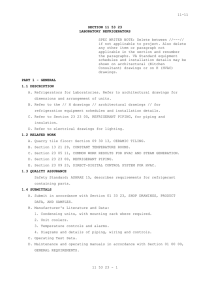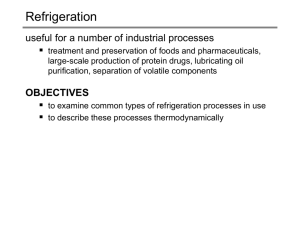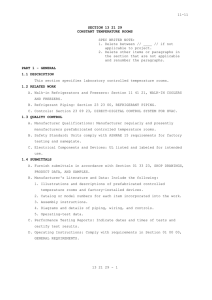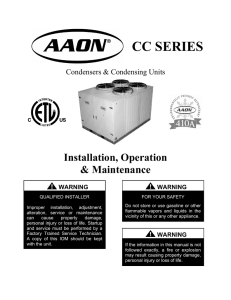11-11 SPEC WRITER NOTE: Delete between //---//
advertisement
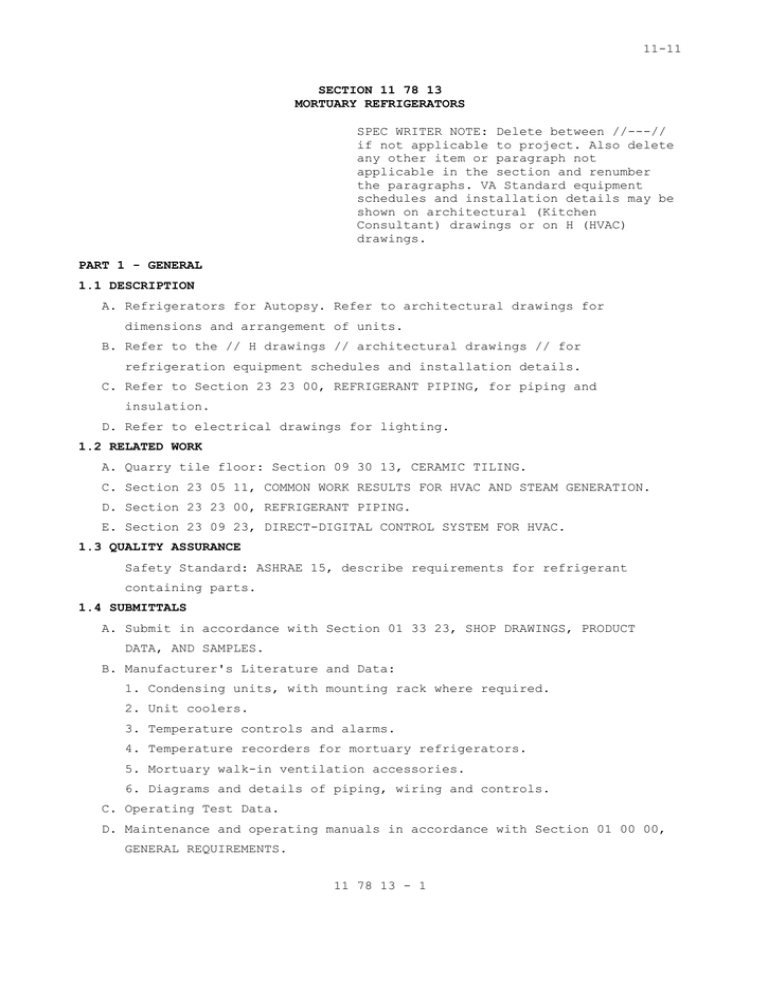
11-11 SECTION 11 78 13 MORTUARY REFRIGERATORS SPEC WRITER NOTE: Delete between //---// if not applicable to project. Also delete any other item or paragraph not applicable in the section and renumber the paragraphs. VA Standard equipment schedules and installation details may be shown on architectural (Kitchen Consultant) drawings or on H (HVAC) drawings. PART 1 - GENERAL 1.1 DESCRIPTION A. Refrigerators for Autopsy. Refer to architectural drawings for dimensions and arrangement of units. B. Refer to the // H drawings // architectural drawings // for refrigeration equipment schedules and installation details. C. Refer to Section 23 23 00, REFRIGERANT PIPING, for piping and insulation. D. Refer to electrical drawings for lighting. 1.2 RELATED WORK A. Quarry tile floor: Section 09 30 13, CERAMIC TILING. C. Section 23 05 11, COMMON WORK RESULTS FOR HVAC AND STEAM GENERATION. D. Section 23 23 00, REFRIGERANT PIPING. E. Section 23 09 23, DIRECT-DIGITAL CONTROL SYSTEM FOR HVAC. 1.3 QUALITY ASSURANCE Safety Standard: ASHRAE 15, describe requirements for refrigerant containing parts. 1.4 SUBMITTALS A. Submit in accordance with Section 01 33 23, SHOP DRAWINGS, PRODUCT DATA, AND SAMPLES. B. Manufacturer's Literature and Data: 1. Condensing units, with mounting rack where required. 2. Unit coolers. 3. Temperature controls and alarms. 4. Temperature recorders for mortuary refrigerators. 5. Mortuary walk-in ventilation accessories. 6. Diagrams and details of piping, wiring and controls. C. Operating Test Data. D. Maintenance and operating manuals in accordance with Section 01 00 00, GENERAL REQUIREMENTS. 11 78 13 - 1 11-11 1.5 APPLICABLE PUBLICATIONS A. The publications listed below form a part of this specification to the extent referenced. The publications are referenced in the text by the basic designation only. B. Air-Conditioning and Refrigeration Institute (ARI): 420-00 ................. Unit Coolers for Refrigeration. 520-04 ................. Performance Rating of Positive Displacement Condensing Units. C. American Society of Heating, Refrigerating and Air Conditioning Engineers (ASHRAE): 15-10 .................. Safety Standard for Refrigeration Systems PART 2 - PRODUCTS 2.1 CONDENSING UNITS A. Comply with ARI Standard 520. Air cooled, water cooled or combination air/water cooled type as shown, motor driven integral compressor, motor starter, condenser, receiver, common base, and safety/operational controls. Receiver capacity shall be not less than 125 percent of system refrigerant charge. For units racked one above the other and for units installed in a closet, provide a factory fabricated steel rack extending approximately 1150 mm (45 inches) above the floor. For larger freezers provide two condensing units and unit coolers with independent refrigeration systems as shown. Do not locate compressors on top of refrigerator or freezers. B. Provide positive oil lubrication and oil level indicating device for each compressor. Provide water regulating valve for water cooled unit. C. Compressor Motor: Squirrel cage induction type of ample size for continuous operating at maximum compressor performance indicated. Provide inherent (Klixon) protection, in compressor terminal box, for each phase of motor. D. Pressure Switches: Automatic reset low pressure switch, and automatic or manual reset high pressure cutout. E. Air Cooled Condensing Units: 1. High efficiency type piped and automatically controlled to operate at lower head pressures during low ambient temperature conditions, designed and weather-proofed for outdoor installation, to operate satisfactorily at winter ambient temperatures down to ____ degrees C (F), and be provided with crankcase and receiver heaters. SPEC WRITER NOTE: Insert temperature of 6 degrees C (10 degrees) below the 99% column in ASHRAE Handbook weather data. 11 78 13 - 2 11-11 2. The condenser fans shall be driven by permanent split capacitor motors. 2.2 UNIT COOLERS A. Comply with ARI Standard 420. Units shall be UL listed, forced-ventilation type integral defrosting, internal or external refrigerant distributor, single or multiple fans and motors, drip-pan, deflectors, aluminum or baked-enamel steel housing, hangers, and all accessories. B. Motors: Permanent split capacitor type in accordance with Section 11 05 12, General Motor Requirements for Equipment. Provide motors with thermal overload protection. Provide manual starting switch. C. Drain Pans: Galvanized sheet steel. Provide additional drain pans under uncovered refrigerant connections, and interconnect them with main drain pan. For freezer units provide electrically heated drain pan. D. Defrost Provision: 1. Refrigerators: Defrost shall occur during compressor off cycle with evaporator fan running continuously. 2.3 PIPING, PIPE INSULATION, AND REFRIGERANT AND OIL CHARGES Refer to Section 23 23 00, REFRIGERANT PIPING. 2.4 EQUIPMENT IDENTIFICATION REQUIREMENTS A. Refer to Section 23 05 11, COMMON WORK RESULTS FOR HVAC AND STEAM GENERATION. B. Identify all refrigeration equipment and alarm devices. SPEC WRITER NOTE: Where both, a freezer and a refrigerator is required, then the preferred configuration is as specified. The designer may modify to have separate entry to refrigerator and freezer, if so required by the user. 2.5 AUTOPSY REFRIGERATOR SPECIAL ITEMS A. Seven day temperature recorder: Electric clock operated, wall mounted cabinet, mounted on or adjacent to the refrigerator approximately 1.5m (5'- 0") above the floor. 1. Sensing bulb: Remote type, mercury filled, located in refrigerators recommended by the manufacturer. 2. Charts: Approximately 200 mm (8-inch) diameter with range of -18 to 38 degrees C (0 to 100 degrees F). Provide 100 charts, replacement pen and ink supply. 3. New Mortuary Refrigerators provided in existing buildings shall be installed so that the finished floor levels of the refrigerators and 11 78 13 - 3 11-11 the general floor levels are the same. This shall be accomplished by installing a prefabricated refrigerator enclosure, minus the installed enclosure floor, directly upon the floor slab. The enclosure perimeter shall be sealed against air and waste leakage, and insulation with vapor barrier placed below the slab to avoid condensation where required by climate or location. B. Exhaust ventilation provision: 1. Ceiling grille: 150 mm by 150 mm (6-inch by 6-inch), stainless steel, with 13 mm (1/2-inch) bars at 45 degree angle to exhaust 50 CFM with make up air for exhaust through the open door. Provide stainless steel duct extension to six inches above the top of the ceiling panel. 2. Door switch: Mount switch in door frame and extend wiring to a junction box above the ceiling. The purpose of the switch is to activate an automatic exhaust damper when the door is open. C. No viewport required in entrance doors. PART 3 - EXECUTION 3.1 INSTALLATION A. Install refrigeration equipment as described in the respective manufacturer's instructions. Make panel joints tight and seal all panel penetrations to prevent condensation or frosting. 1. Unit cooler: NSF approval requires that the unit be suspended at 90 mm (3-1/2 inches) minimum distance below the ceiling to allow cleaning the top of the unit cooler. 2. To the extent feasible, mount pipe, conduit, and instrumentation on the exterior and pass thru neatly drilled penetrations to the lights or other devices. B. Piping, Pipe Insulation and Refrigerant: Provide in accordance with Section 23 23 00, REFRIGERANT PIPING. C. Controls Installation: As specified in Section 23 09 23, Direct-Digital Controls Systems for HVAC. 3.2 REFRIGERATOR START-UP, AND PERFORMANCE TESTS AND INSTRUCTIONS A. Start-up Temperature Reduction: On start-up, reset the room thermostats daily for a maximum temperature drop of 8 degrees, on C scale (15 degrees on F scale per day down to 2 degrees C (36 degrees F), and a maximum of 6 degrees on C scale, (10 degrees on F scale) per day between 2 degrees C (36 degrees F) and final operating temperature. 11 78 13 - 4 11-11 B. Perform test in accordance with Section 01 00 00, GENERAL REQUIREMENTS. Operate each system and record conditions hourly for eight hours. Submit the following information: 1. Station, Building and System Identification, Contractor, Date and Time. 2. Compressor nameplate data: Make, model, horsepower, RPM, refrigerant and charge in pounds. 3. Compressor operation: Approximate percentage running time, pressure gage readings, actual amps (starting and running), condenser water temperature in and out, or condenser entering air temperature. 4. Room temperatures. 5. Defrost and drain functions of unit coolers. Demonstrate alarm functions. C. By arrangement with the Resident Engineer, 24 hours in advance, use the start-up and test period for required operation and maintenance instructions to VA personnel in accordance with Section 01 00 00, GENERAL REQUIREMENTS. - - - E N D - - - 11 78 13 - 5
